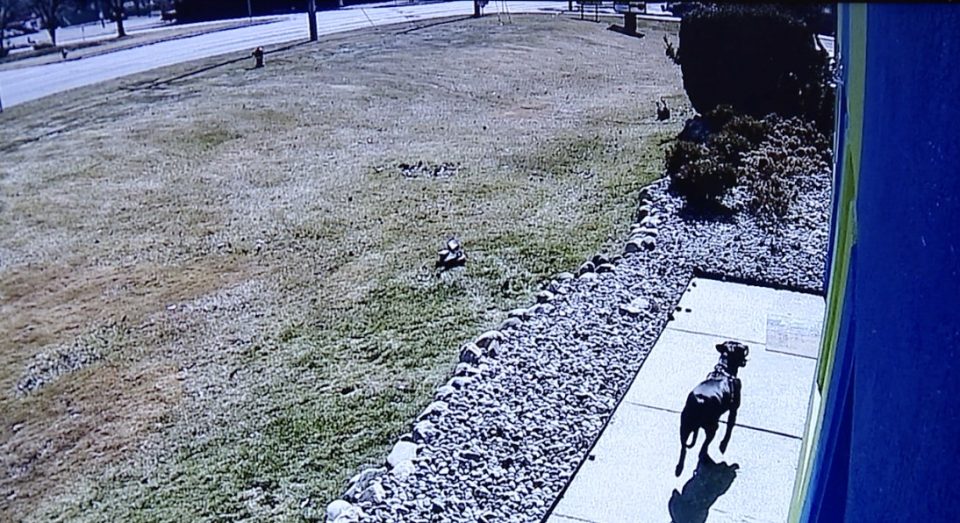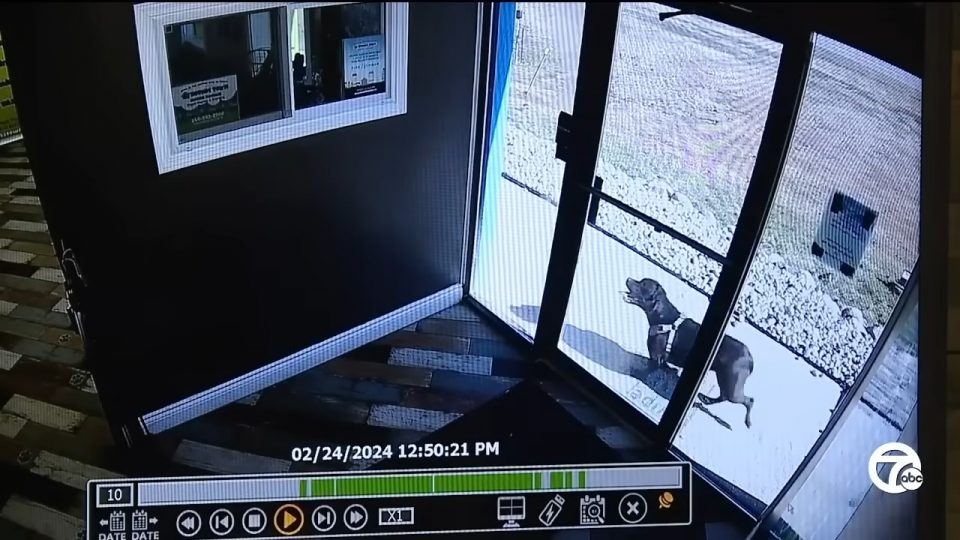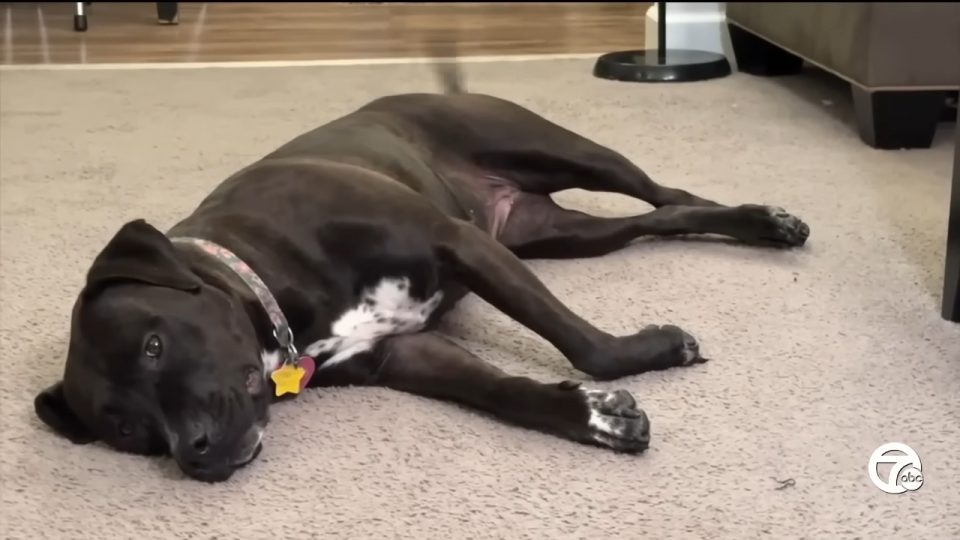Aries is a smart three-year-old Pitbull mix dog who, after getting into a car accident with her owner, knew exactly where to go and who to ask for help.
Melissa Fickel, from Detroit, adopted Aries more than three years ago, when, after fostering animals for so long, she realized that she wanted a forever friend of her own.
Ever since, the two have been inseparable, spending every hour of the day together.
On the day of the accident, the two were on their way to the park when another car ran into Melissa.
Quick-Thinking Aries Looking For Help

No one was injured in the accident and the damage was pretty minor, but Aries got spooked and quickly jumped out of the car, running away.
“I had the windows down because Aries likes to hang her head out and as soon as there was that smack, as soon as I felt and heard it, almost instantaneously, she was out of the window,” Melissa told local television station WXYZ Detroit.
Melissa had to stay at the site of the accident to deal with the police and insurance, but she was deeply worried about Aries. “I can’t really think about it because so many things could’ve happened,” Melissa said.
Aries could have run into traffic or some other danger, but thankfully, she was very smart and knew exactly where to go.

About a mile down the road was a place Aries frequently visited and she obviously felt safe enough to go ask for help.
Aries ran to Hounds Town – Detroit Metro doggy daycare. The owner of the daycare, Travis Ogden, immediately recognized Aries as one of their clients and provided her shelter, noticing that she was scared.
Safe At The Daycare

Aries showed up at the doggy daycare around noon, just when the employees were taking a little break.
While they were in the front lobby, a black blur outside of their front door caught their eye.
On the surveillance video of the daycare, you can clearly see little Aries running straight to the front door, jumping up and down, and trying to get inside.
When one of the employees walked out, he saw a dog standing right outside the front door, a little scared and panting.
Fortunately, the owner recognized Aries. “She was like, ‘this is where I go and this is where I stay.’ She just seemed like she knew what to do,” Ogden told WXYZ.
Aries probably picked up the building’s scent and ran there because she felt safe at her daycare.

She was freaked out in the beginning, but calmed down quickly. While Melissa was still worrying about her furry friend, she received a call from Ogden.
“Luckily then he called me and said ‘she’s here’, and I literally sank to the ground,” Melissa said, evidently relieved that her companion was safe and sound.
So many things could have gone wrong, but thankfully, Aries is one smart dog who knows how to keep herself and her owner safe.
The two were shortly after reunited, and according to Melissa, Aries is back to her old self and loving car rides.
Ever noticed your furry friend digging up the backyard to stash away a bone? It’s a common behavior seen in many dogs that often leaves us wondering about their motives. Dogs have an innate instinct to bury things, dating back to their wild ancestors. This behavior is more than just a quirky habit; it’s rooted deep in their nature.
Your pup’s burying behavior is linked to survival tactics from their past. Back in the day, wild dogs buried food to save it for later when resources were scarce. This instinctual behavior of burying bones is a fascinating glimpse into your dog’s primal instincts and serves as a window into their evolutionary past. So, the next time you catch your canine companion burying a bone in the backyard, remember, it’s not just about hiding a treat; it’s a glimpse into their wild heritage.
Understanding the Canine Instinct
The History Behind the Behavior
Dogs have a fascinating history of burying bones that dates back to their wild ancestors. In the past, wolves and wild dogs would bury food to store it for later when food was scarce. This buried food acted as a hidden reserve that they could rely on in lean times. As domesticated dogs evolved from these wild canines, the urge to bury items, like bones, remained as part of their instinctual behavior.
Modern Dog Habits and Ancestral Traits
Even in today’s modern world, where dogs have plenty of food provided by their owners, the instinct to bury bones persists. This behavior is deeply ingrained in their DNA and serves as a link to their ancestral past. While your furry companion may not need to bury bones for survival, the act of burying is a natural behavior that provides them with a sense of security and comfort. So, when you catch your pup burying a bone in the backyard, remember, it’s not just a random act but a deeply rooted instinct passed down through generations.
The Science of Burying Behavior
Nutritional Security for Later
When your dog buries bones, it’s not just an old habit from their wild ancestors; it’s a clever way to ensure they have food when they need it. By burying bones, dogs are instinctively storing them for leaner times. This behavior stems from their innate survival instincts to secure food reserves for later consumption. So, next time you catch your furry friend burying a bone, remember they are just preparing for a rainy day, doggy style!
Natural Preservation Techniques
Burying bones is like your dog’s natural refrigerator. By burying their bones in the ground, dogs are actually preserving them. The cool and slightly moist environment of the earth helps slow down the decomposition process of the bones, keeping them relatively fresh for later enjoyment. It’s a primitive but effective way for dogs to store their favorite treats and ensure they have a snack available when they crave it.
How Dog’s Ancestors Influence Today’s Behaviors
Wild Relatives and Survival Tactics
Dogs’ burying behavior traces back to their wild ancestors. In the past, wild dogs buried food to hide it from potential competitors. This survival instinct helped them secure resources when food was scarce. Even though your pet dog now has a full food bowl, this ancestral trait remains ingrained. So, when your pup buries a bone in the backyard, it’s simply following its wild heritage.
The Transition from Wild to Domesticated
As dogs transitioned from wild to domesticated animals, their behavior adapted, but some instincts persisted. The act of burying bones evolved from a survival tactic to a more symbolic gesture. While dogs no longer need to hide food for survival, burying bones serves as a form of comfort and security. This behavior reflects the deep-rooted nature of our furry companions, honoring their past while thriving in the present.
Observing Your Dog’s Burying Habits
Signs That Your Dog is About to Bury Something
When your dog is about to bury a bone or treat, you may notice specific behaviors indicating its intention. One common sign is when your dog starts digging in a particular spot repeatedly. This digging may look frantic or purposeful, as if your dog is trying to create a hiding place for the item.
Another sign to watch for is if your dog appears restless or protective of the treat. Your dog might carry the bone around the house, whine, or even growl if someone tries to take it away. These behaviors suggest that your dog values the treat and is looking for a secure place to stash it.
How to Provide a Safe Environment for Burying
Creating a safe environment for your dog to bury its treasures can help satisfy its natural instincts. One way to do this is by designating a specific digging area in your yard where your dog is allowed to bury items. Providing a sandbox or a designated patch of soil can give your dog a designated spot to bury its bones without disrupting your garden or yard.
Additionally, consider giving your dog a variety of toys and chews to bury. Rotating different items can keep your dog engaged and prevent it from fixating on burying only one type of treat. By offering a selection of bury-worthy items, you can cater to your dog’s natural instincts and provide it with a safe and secure space to enjoy its treasures.
Addressing Excessive Burying
When Burying Becomes a Problem
If your dog’s burying habit starts causing issues, it’s essential to address it promptly. Common problems can include your dog burying important items like keys or your shoes, which can be frustrating. Excessive burying can also lead to your yard resembling a minefield of hidden treasures. It’s vital to intervene if the behavior becomes problematic.
- Supervise and Redirect: Keep an eye on your dog while they are outside and redirect their burying behavior by offering toys or treats as alternatives.
- Limit Access: If your dog tends to bury items indoors, consider confining them to certain areas where burying isn’t allowed.
- Provide Interactive Toys: Engage your dog with interactive toys that keep them mentally stimulated and physically active, reducing the urge to bury.
- Consult a Professional: If the burying behavior persists despite your efforts, seek advice from a professional dog trainer or behaviorist to address any underlying issues.
Enrichment Activities to Satisfy Burying Instincts
Alternatives to Burying Bones
To provide your dog with alternative ways to satisfy its burying instincts, you can introduce activities that mimic the behavior without the need for burying objects. Try hiding treats or toys around the house or yard for your dog to find. This engages their natural scavenging instincts while keeping your belongings safe.
Interactive Toys and Games
Investing in interactive toys and games can offer mental stimulation and physical activity that fulfill your dog’s burying desires in a constructive manner. Toys that dispense treats when manipulated can simulate the rewarding experience of burying something and provide entertainment for your furry companion.
By incorporating these enrichment activities into your dog’s routine, you can help manage their burying instincts effectively while enhancing their overall well-being and creating a harmonious bond between you and your pet.
Conclusion
Now that you understand why dogs have this quirky habit of burying bones, you can help satisfy their natural instincts in a positive way. By providing enrichment activities and interactive toys, you can keep your furry friend mentally stimulated and physically active. This not only prevents excessive burying but also strengthens your bond with your pet. So, next time you see your dog trying to bury something, remember it’s just their way of feeling secure and comfortable. Embrace this behavior and turn it into a fun and engaging activity for both of you. Happy burying!
Frequently Asked Questions
Why do dogs bury bones?
Dogs bury bones due to ancestral survival instincts for security and comfort. This behavior continues in domesticated dogs.
How can I tell if my dog is about to bury something?
Signs that a dog is about to bury something include digging at the ground, wandering around with an item in their mouth, and covering up the item with their nose or paws.
What can I do to manage my dog’s burying behavior?
Provide enrichment activities like hiding treats or toys to satisfy burying instincts without the need to bury objects. Interactive toys and games can offer mental stimulation and physical activity to fulfill burying desires in a constructive manner.
[no_toc]

Hey there, I’m Janet Brooks, a dog-loving student from California. I’m all about helping pups in need, especially those without homes. Me and my awesome friends work together to give shelter and love to stray dogs. Oh, and I also write blogs about dogs to share helpful info.